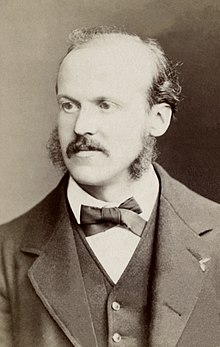
Back ألفونس ميلن إدواردس Arabic الفونس ميلن ادواردس ARZ Alphonse Milne-Edwards Catalan Alphonse Milne-Edwards German Alphonse Milne-Edwards EO Alphonse Milne-Edwards Spanish Alphonse Milne-Edwards Finnish Alphonse Milne-Edwards French Alphonse Milne-Edwards GL Alphonse Milne-Edwards ILO
Alphonse Milne-Edwards | |
|---|---|
 | |
| Born | 13 October 1835 |
| Died | 21 April 1900 (aged 64) |
| Known for | Discovery of tropical birds from prehistoric France |
| Parent |
|
| Awards | Gold medal of the Royal Geographical Society |
| Scientific career | |
| Institutions | Muséum National d'Histoire Naturelle |
| Author abbrev. (botany) | Milne-Edw. |
Alphonse Milne-Edwards (Paris, 13 October 1835 – Paris, 21 April 1900) was a French mammalogist, ornithologist, and carcinologist. He was English in origin, the son of Henri Milne-Edwards and grandson of Bryan Edwards, a Jamaican planter who settled at Bruges (then in France).[1]
Milne-Edwards obtained a medical degree in 1859 and became assistant to his father at the Jardin des Plantes in 1876.[1] He became the director of the Muséum National d'Histoire Naturelle in 1891, devoting himself especially to fossil birds and deep-sea exploration. In 1881, he undertook a survey of the Gulf of Gascony with Léopold de Folin and worked aboard the Travailleur and the Talisman, researching the seas off the Canary Islands, the Cape Verde Islands, and the Azores. For this, he received a gold medal of the Royal Geographical Society.[1]
His major ornithological works include Recherches Anatomiques et Paléontologiques pour servir a l'Histoire des Oiseaux Fossiles de la France published in two parts in 1867 and 1872, Recherches sur la Faune ornithologique étiente des iles Mascareignes et de Madagascar 1866–1874 and Recherches pour servir à l'histoire naturelle des mammifères 1868–1874.[2] His study of fossils led to the discovery of tropical birds such as trogons and parrots from prehistoric France.[1] He worked with Alfred Grandidier on L'Histoire politique, physique et naturelle de Madagascar.[3]
Milne-Edwards also described at least one plant taxon; a species of gutta-percha collected from the island of Grande Comore, Comoros, by ornithologist Léon Humblot, which Milne-Edwards named Isonandra gutta.[4] (I. gutta is now considered to be a taxonomic synonym of Palaquium gutta (Hook.) Burck,[5] and a homonym of its basionym Isonandra gutta Hook..)[6]
A subspecies of Central American lizard, Holcosus festivus edwardsii Bocourt, 1873, is named in honor of Milne-Edwards.[7]
- ^ a b c d Anonymous (1900). "Obituary – Professor Alphonse Milne-Edwards" (PDF). The Auk. 17 (3): 320–321. doi:10.2307/4069150. JSTOR 4069150.
- ^ "Review of The Fauna of British India. Part I. 'Mammalia', edited by W. T. Blanford; Recherches pour servir à l'Histoire Naturelle des Mammifères par Alphonse Milne Edwards". The Quarterly Review. 186: 394–419. October 1897.
- ^ Anonymous (1922). "Obituary – Albert Grandidier" (PDF). The Auk. 39 (3): 451–456 (453). doi:10.2307/4073496. JSTOR 4073496.
- ^ Bulletin du Muséum d'Histoire Naturelle 5: 187–189. 1899. "Name - Isonandra gutta Milne-Edw". Tropicos. Saint Louis, Missouri: Missouri Botanical Garden. Archived from the original on 20 August 2019. Retrieved 20 August 2013.
- ^ "TPL, treatment of Isonandra gutta Hook". The Plant List; Version 1. (published on the internet). Royal Botanic Gardens, Kew and Missouri Botanical Garden. 2010. Retrieved 20 August 2013.
- ^ "Name - Isonandra gutta Milne-Edw. homonyms". Tropicos. Missouri Botanical Garden. Archived from the original on 20 August 2019. Retrieved 20 August 2013.
- ^ Beolens, Bo; Watkins, Michael; Grayson, Michael (2011). The Eponym Dictionary of Reptiles. Baltimore: Johns Hopkins University Press. xiii + 296 pp. ISBN 978-1-4214-0135-5. ("Edwards", p. 80).
- ^ International Plant Names Index. Milne-Edw.